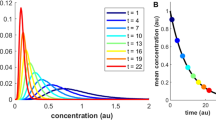Abstract
Many synthetic concentration measures are derived from concentration curves. The ordinate of the concentration curves may be utilized as point concentration measure (local concentration). In this paper, after having analysed the behaviour of the concentration curves derived from the Lorenz curve and the behaviour of the Z(p) curve, the formal requirements that must be fulfilled by point concentration measure have been specified. The first of these requirements states that a point concentration measure must not have a forced behaviour. Unfortunately, the widely utilized Lorenz curve has a forced behaviour. Consequently, it does not seem reasonable to use the ordinate of the Lorenz curve as point concentration measure. On the contrary, the Z(p) curve has not a forced behaviour and it has shown a great suitability for representing different real distributions as well as different distributive models. The Z(p) point measure satisfies also all the other requirements, so that it may be utilized as point concentration measure.
Access this chapter
Tax calculation will be finalised at checkout
Purchases are for personal use only
Preview
Unable to display preview. Download preview PDF.
Similar content being viewed by others
References
Amato, V. (1987). Contributo della Scuola Statistica Italiana alia costruzione di classi di indici di concentrazione. in La distribuzione personale del reddito: problemi di formazione, di ripartizione e di misurazione, ed. M. Zenga, Milano: Vita e Pensiero, pp. 3–25.
Arnold, B. (1987). Majorization and the Lorenx Order: a brief introduction, Berlin: Springer-Verlag.
Bonferroni, C.E. (1930). Elementi di statistica generale, Firenze: Libreria Seeber.
Bortkiewicz, L. von (1930). Die Disparitätsmasse der Einkommenstatistik, in XIXe Session de l’Institut International de Statistique, Haag.
Bowley, A.L. (1902). Elements of Statistics, London: King and Son, p. 136.
Brunazzo, A. (1987). Variazioni nel diagramma di concentrazione di M. Zenga. in La distribuzione personale del reddito: problemi di formazione, di ripartizione e di misurazione, ed. M. Zenga, Milano: Vita e Pensiero, pp. 48–61.
Dancelli, L. (1989). Confronti fra le curve di concentrazione Z(p) e L(p) nel modello di Dagum, working paper, Universitá di Brescia, Dipartimento di Statistica e Matematica.
De Vergottini, M. (1940). Sul significato di alcuni indici di concentrazione, Giornale degli Economist e Annuali di Economia, pp. 317–347.
Gini, C. (1914). Sulla misura-della concentrazione e della variabilitá dei caratteri, in Atti del Reale Istituto Veneto di Scienze, Lettere ed Arti, Tomo LXXIII, parte seconda, pp. 1203–1248.
Grassini, L. and Rigo, P. (1986). Alcuni aspetti formali delle misure di variabilitá e di concentrazione, in Atti della XXXIII Riunione Scientifica della SIS, Vol. II, Bari, pp. 353–361.
Kakwani, N.C. (1980). Income Inequality and Poverty, New York: Oxford University Press.
Lorenz, M.O. (1905). Methods of measuring the concentration of wealth, American Statistical Association, New Series, N. 70, pp. 209–219.
Mendershausen, H. (1939). On the measurement of the degree of inequality of income distributions, Cowles Commission for Research in Economics, University of Chicago.
Michal, J.M. (1978). Size Distribution of household incomes and earnings in developed socialist countries, in Personal Income Distribution, ed. A. Krelle and A.F. Shorrocks, Amsterdam: North- Holland Publ. Co.
Nygård. F. and Sandrström, A. (1981). Measuring income inequality, Stockholm: Almqvist and Wiksell International.
Salvaterra, T. (1985). Problemi di calcolo della curva di concentrazione di Zenga e dell’indice di concentrazione ξ in Pubblicazioni dell’Istituto di Statistica e di Ricerca Operativa dell’Universitá di Trento.
Salvaterra, T. (1989). Confronti fra diagrammi ed indici di concentrazione in alcune distribuzioni empiriche, paper presented at the conference on Income Distribution by Size, Pavia, September 1989.
Vielrose, E. (1978). Patterns of the distribution of Earnings in Poland, in Personal Income Distribution, ed. A. Krelle and A.F. Shorrocks, Amsterdam North-Holland Publ. Co. Wiles, P.J.D. (1974). The Distribution od Income, East and West Amsterdam.
Wiles, P.J.D. (1975). Stalin and British Top Salaries, in The Personal Distribution of Incomes, ed. A.B. Atkinson, London.
Wiles, P.J.D. (1978). Our Shaky Data Base, in Personal Income Distribution, ed. A. Krelle and A.F. Shorrocks, Amsterdam: North-Holland Publ. Co.
Zenga, M. (1984a). Tendenza alia massima ed alia minima concentrazione per variabili casuali continue, Statistica, N. 4, pp. 619–640.
Zenga, M. (1985). Un secondo indice di concentrazione basato sui rapporti fra quantili di reddito e quantili di popolazione, Rivista di Statistica Applicata, N. 3, pp. 143–154.
Zenga, M. (1987). II contributo degli italiani alio studio della concentrazione, in La distribuzione personale del reddito: problemi di formazione, di ripartizione e di misurazione, ed. M. Zenga, Milano: Vita e Pensiero, pp. 307–328.
Author information
Authors and Affiliations
Editor information
Editors and Affiliations
Rights and permissions
Copyright information
© 1990 Springer-Verlag Berlin Heidelberg
About this paper
Cite this paper
Zenga, M. (1990). Concentration Curves And Concentration Indexes Derived From Them. In: Dagum, C., Zenga, M. (eds) Income and Wealth Distribution, Inequality and Poverty. Studies in Contemporary Economics. Springer, Berlin, Heidelberg. https://doi.org/10.1007/978-3-642-84250-4_7
Download citation
DOI: https://doi.org/10.1007/978-3-642-84250-4_7
Publisher Name: Springer, Berlin, Heidelberg
Print ISBN: 978-3-540-52863-0
Online ISBN: 978-3-642-84250-4
eBook Packages: Springer Book Archive




